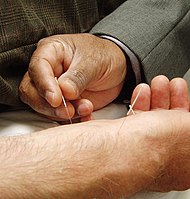
Photo from wikipedia
BACKGROUND Reflex testing is necessary to achieve the objectives of hepatitis C elimination. However, in 2017 only 31% of Spanish hospitals performed reflex test. As a consequence of that finding,… Click to show full abstract
BACKGROUND Reflex testing is necessary to achieve the objectives of hepatitis C elimination. However, in 2017 only 31% of Spanish hospitals performed reflex test. As a consequence of that finding, reflex testing was recommended by scientific societies involved in the diagnosis and treatment of hepatitis C. OBJECTIVE To evaluate the degree of implementation of reflex testing in 2019 and to know the implementation of rapid diagnostic and/or dried blood spot testing (RDT and / or DBS) in Spanish hospitals. METHODS Cross-sectional study through a survey conducted in October 2019 to Spanish general hospitals with at least 200 beds, public or private with teaching accreditation. RESULTS 129 (80%) hospitals responded. Reflex testing is performed by 89% of the centers vs. 31% in 2017 (P<.001). From 2017 to 2019, centers using alerts to improve continuity of care increased from 69% to 86% (P=.002). In 2019, 11% of centers can determine anti-HCV in dried spot, 15% viremia in dried spot, 0.85% anti-HCV in saliva, and 37% of antibodies and/or viremia with point of care test. 43% of hospitals have at least one diagnostic method with RDT and/or DBS. CONCLUSION The implementation of reflex testing has increased significantly, reaching 89% of hospitals in 2019. The recommendations of scientific societies could have contributed to the implementation of reflex testing. On the other hand, access to RDT and/or DBS is insufficient and initiatives are needed to improve their implementation.
Journal Title: Enfermedades infecciosas y microbiologia clinica
Year Published: 2020
Link to full text (if available)
Share on Social Media: Sign Up to like & get
recommendations!